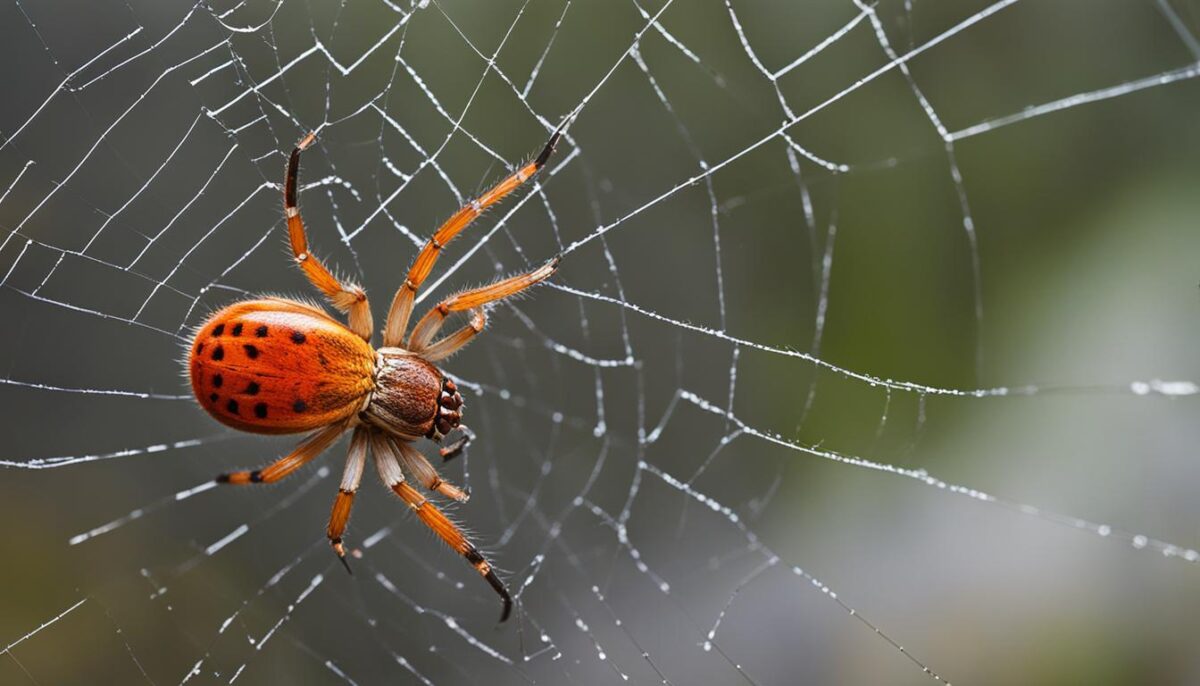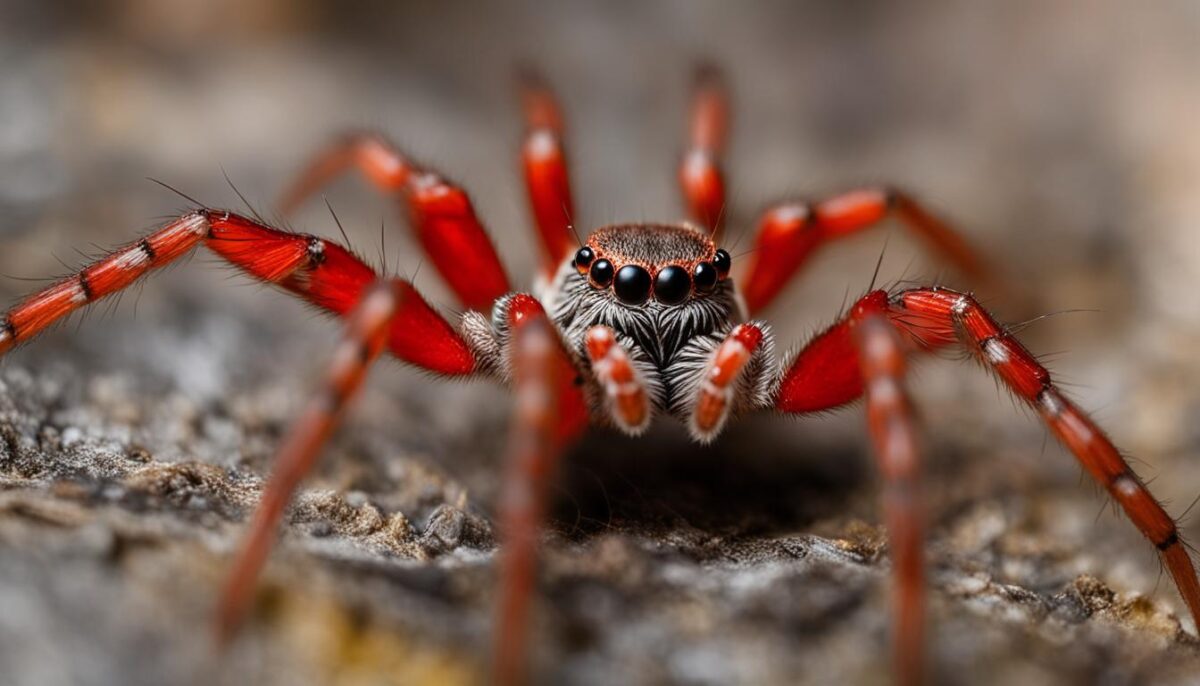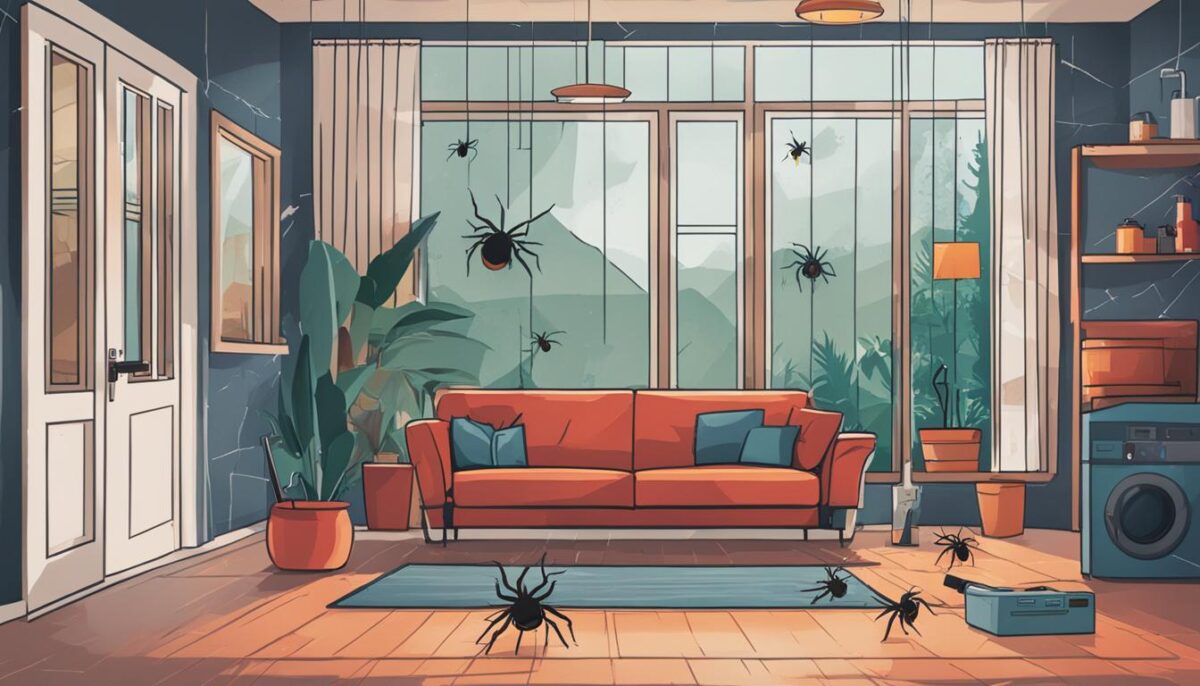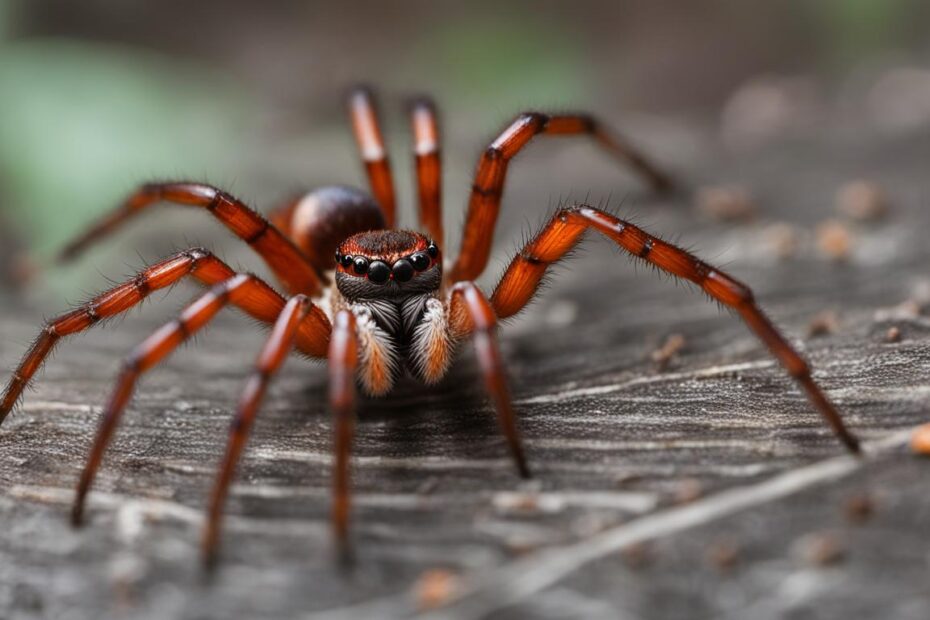Welcome to our red-legged house spider identification guide! If you’ve encountered a house spider with red legs and want to learn more about it, you’ve come to the right place. In this guide, we will explore various red-legged spider species, their habitats, behavior, and essential tips for identification and prevention. Let’s delve into the intriguing world of these arachnids and discover more about them.
Key Takeaways:
- Red-legged spiders encompass diverse species from families such as cobweb spiders, widow spiders, jumping spiders, and ground sac spiders.
- Some red-legged spiders, like black widows and brown widows, have distinctive red markings, such as the iconic hourglass shape.
- Red-legged spiders can be found in various habitats, including gardens, wooded areas, and sometimes even inside homes.
- While most are harmless, it is crucial to identify venomous species like black widows and brown widows.
- To prevent spider infestations, maintain cleanliness, seal cracks, eliminate clutter, and reduce other insect populations that may attract spiders.
House Spider with Red Legs: Types and Characteristics
When it comes to spiders with red legs, there are several different types and characteristics to consider. Common red-legged spiders include cobweb spiders, widow spiders, jumping spiders, and ground sac spiders.
Cobweb Spiders
One of the most well-known red-legged spiders is the cobweb spider, which includes species like black widows and brown widows. These spiders typically have red markings, often in the form of an hourglass shape on the ventral side of the abdomen. While cobweb spiders are venomous, they rarely bite humans.
Jumping Spiders and Ground Sac Spiders
Jumping spiders and ground sac spiders may also display red markings on their bodies. Jumping spiders, known for their impressive leaping abilities, can have red markings on their backs. Ground sac spiders, on the other hand, may have red markings on their abdomens. It’s important to note that not all red-legged spiders are venomous, but it is best to exercise caution and avoid direct contact with any spider.

Red-legged spiders play a crucial role in controlling insect populations in their habitats. As natural predators, they help keep the population of pests in check, ensuring a balanced ecosystem. By reducing the number of insects, these spiders contribute to maintaining the overall health of their habitats and surrounding areas.
To prevent spider infestations, it is essential to take proactive measures. Keeping homes and outdoor spaces clean and free from clutter is key to reducing potential hiding spots for spiders. Regularly removing debris and sealing any cracks or openings will help minimize their entry into buildings.
Another important aspect of spider infestation prevention is controlling other insect populations that may attract spiders. By implementing effective pest control methods, such as removing standing water, practicing good sanitation practices, and sealing food sources, you can effectively deter spiders from establishing their habitats in your surroundings.
Spider Control Methods
When dealing with spider infestations, various control methods can be employed:
- Using natural remedies and deterrents: Many natural ingredients like peppermint oil, vinegar, and citrus can repel spiders. These can be used as sprays or placed strategically around your home’s entry points and potential hiding spots.
- Applying chemical treatments: In severe infestations, chemical control methods may be necessary. Hiring a professional pest control service will ensure safe and effective application of appropriate insecticides.
- Implementing physical barriers: Installing screens on windows and doors can prevent spiders from entering your home while allowing ventilation to remain intact. Sealing gaps in doors, windows, and walls is also important in creating a barrier against spider intrusion.
- Maintaining a clean environment: Regular cleaning, vacuuming, and dusting help eliminate spider webs and reduce potential hiding spots. Removing debris, such as piles of wood or leaves, is also essential in creating an environment that is less appealing for spiders.
By taking these preventive measures and implementing effective control methods, you can significantly reduce the likelihood of spider infestations in your living spaces. Stay vigilant and proactive in keeping your habitat spider-free.
Identifying Venomous Spiders with Red Legs
While most red-legged spiders are harmless, it is essential to be able to distinguish venomous species, such as black widows and brown widows.

| Spider Species | Physical Characteristics |
|---|---|
| Black Widow | Black, glossy body Red hourglass marking on ventral side of abdomen |
| Brown Widow | Light brown body Orange or red hourglass marking |
If bitten by a venomous spider, it is important to be aware of the symptoms, which may include:
- Pain
- Swelling
- Redness
- Nausea (in severe cases)
- Difficulty breathing (in severe cases)
To address venomous spider infestations, professional spider extermination techniques should be employed. It is crucial to rely on experts who utilize safe and effective methods to eliminate these dangerous spiders.
Preventing Red-Legged Spider Infestations
To prevent red-legged spider infestations, it is important to take proactive measures and implement effective spider control methods. By following these spider infestation prevention techniques, you can create a spider-free environment in your home.
- Eliminate Potential Hiding Places: Regularly clean and declutter your living spaces to remove any hiding spots for spiders. Pay close attention to areas such as closets, attics, basements, and dark corners.
- Seal Cracks and Openings: Inspect your home for any cracks or openings that spiders could use as entry points. Seal these gaps using caulk or weatherstripping to prevent spiders from gaining access to your living areas.
- Reduce Other Insect Populations: Spiders are attracted to places with abundant food sources. Minimize other insect populations in and around your home by properly storing food, sealing trash containers tightly, and keeping your outdoor areas clean and free of debris.
- Install Screens: Adding screens to windows and doors is an effective way to keep spiders out while still allowing fresh air to circulate. Make sure the screens have no tears or holes that spiders can squeeze through.
If despite your best efforts, a spider infestation occurs, it is recommended to seek professional help. Experienced pest control services have the expertise and specialized spider extermination techniques to safely eliminate spiders from your home.

By following these spider infestation prevention methods and seeking professional spider extermination services when needed, you can effectively control and prevent red-legged spider infestations in your home.
Handling Red-Legged Spider Bites
If you’ve been bitten by a red-legged spider, it’s crucial to seek medical attention, especially if you suspect it may be a venomous species. Spider bites can cause various symptoms, including pain, swelling, redness, and in severe cases, nausea and difficulty breathing.
To manage a spider bite, start by cleaning the area with soap and water to prevent infection. Applying a cold compress can help reduce swelling. It’s important to avoid scratching the bite, as this can increase the risk of infection and worsen symptoms. If you experience severe symptoms or are unsure about the spider’s venomous nature, it’s best to consult with medical professionals for appropriate treatment and advice.
Remember, if you suspect a potentially venomous spider bite, it’s always better to be safe than sorry. Seeking medical attention promptly can ensure proper evaluation and treatment.
Conclusion
Red-legged house spiders are a diverse group of spiders that come in various species. While most of them are harmless and actually beneficial in controlling insect populations, it’s crucial to be able to identify venomous species to prevent any potential harm. Regular cleaning, sealing cracks and openings, and minimizing other insect populations are effective methods to prevent spider infestations in your home or other spaces.
If you are bitten by a spider, especially a known venomous species, seeking medical attention for proper treatment is essential. Symptoms of spider bites may include pain, swelling, redness, and in severe cases, nausea and difficulty breathing. It’s important to clean the bite area with soap and water and apply a cold compress to reduce swelling. Avoid scratching the bite to prevent infection.
For effective spider control, it’s recommended to consult with professionals who can provide safe and efficient spider extermination techniques. They can help you identify red-legged spiders, offer preventive measures, and ensure the safety of your home and family. Remember, being knowledgeable about spider identification, prevention, and control methods is the key to living in harmony with these fascinating creatures.
FAQ
How can I identify a red-legged house spider?
Red-legged house spiders can belong to various families, including cobweb spiders, widow spiders, jumping spiders, and ground sac spiders. Some species have red hourglass markings on the ventral side of the abdomen, while others have red markings on their backs. It is important to exercise caution and avoid direct contact with any spider.
What habitats do red-legged spiders prefer?
Red-legged spiders can be found in gardens, wooded areas, and even inside homes. They build webs and catch prey. Some species, like jumping spiders, are active hunters and do not rely on webs. Regular cleaning, sealing cracks and openings, and reducing other insect populations are effective methods to prevent spider infestations.
Are red-legged spiders venomous?
While most red-legged spiders are harmless, some species, such as black widows and brown widows, are venomous. Black widow spiders have a black, glossy body with a red hourglass marking, while brown widows are generally light brown with an orange or red hourglass marking. If bitten by a venomous spider, seek medical attention for proper treatment. Spider extermination should be carried out by professionals using safe and effective techniques.
How can I prevent red-legged spider infestations?
To prevent red-legged spider infestations, it is important to eliminate potential hiding places and reduce other insect populations that may attract spiders. Regular cleaning, sealing cracks and openings, and removing clutter are crucial steps in preventing spiders from entering homes. Installing screens on windows and doors can also help keep spiders out.
What should I do if I get bitten by a red-legged spider?
If bitten by a red-legged spider, especially a known venomous species, seek medical attention. Symptoms of spider bites may include pain, swelling, redness, and, in severe cases, nausea and difficulty breathing. Clean the bite area with soap and water and apply a cold compress to reduce swelling. Avoid scratching the bite to prevent infection. Professionals can provide appropriate medical treatment and advice.

